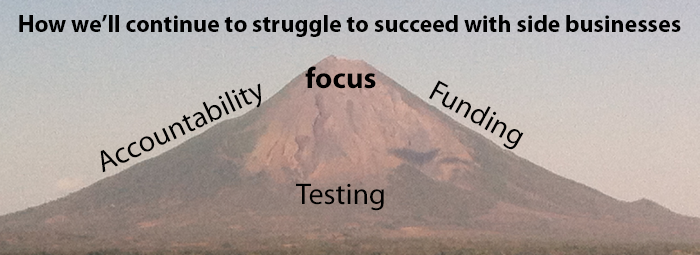It’s not enough to have a good business idea, you must have the time to execute on that idea. Which makes this story from Wired magazine even more impressive.
Dutch programmer and designer Pieter Levels is on a quest to build a new startup every month for a year. It’s more than talk, because he’s already a few months in and has built several startups. He’s doing it all by himself, because he admits to being a control freak. As if that’s not enough, he’s doing this as he travels the world.

I can relate to his story, because we’re doing something similar at AgilityFeat (and I recently moved to Costa Rica, so I get the allure of international living). We are a custom software development shop, which means we have all the skills we need in-house to build awesome products: great UX, design, marketing, and a strong dose of entrepreneurial spirit.
What we lack is the time to execute. For very good reasons – we are swamped right now with new client work and hiring more developers. Good problems to have!
Many services companies go this same route – in fact we’re helping some of our customers do the same thing right now. They have a successful consulting or development business that’s paying the bills. But they also want a side business. For them (and us), this means building something that does not bill by the hour, that makes money while you sleep, and which scratches your entrepreneurial itch.

We’ve talked within our team several times about building up side businesses that we can all profit from. We even brought in expert entrepreneur Patrick Vlaskovits to a beach retreat in Costa Rica in January 2013 to teach us more about customer development and lean startups.
Patrick did a great job teaching our team, but we failed to produce any substantial side businesses in 2013 in part because of the innovator’s dilemma.
Our “real” business of custom software development was just too busy to spend time on innovative side projects!

Equally important, we also had misaligned incentives. Our team is incentivized to work for our clients, because the more they work, the more money they make. This is intentional and a good thing for our clients.
We learned the incentives we offered for our side businesses were not good enough for our team to invest their personal time above and beyond client work:
#1 Future stock options are not a good enough incentive
Not when you have paying client work now.
#2 Not everyone wants to be an entrepreneur
Everyone on our team loves to work with startups, but they don’t all want to be product entrepreneurs themselves. This is a key difference. Loving the atmosphere and creativity of a startup is different than wanting to take on the risk and responsibility of implementing your own ideas in the marketplace.
#3 Working on someone else’s ideas is not motivating
Even for those with the ambition, desire, and foresight to invest their time in a side business. This is human nature. I get most excited about my own ideas too.
#4 Mentorship is not enough
To encourage our team to bring their ideas to the table, we offered to mentor, fund advertising, and help with the business. Those benefits were not enough to pull busy people away from client work.
#5 Client work is the basis of our entire business
We don’t want to force anyone to have sleepless nights trying to balance client work with side businesses, so we never pushed too hard because we don’t want to kill our core business.
Even though our team and our leadership was excited to build our own little startup incubator within AgilityFeat, it went nowhere.
Clearly, a different approach was needed.

We’re making better progress in 2014, but we’re certainly not cranking out a side business every month. We have made three key changes:
#1 Lead from the top
Each member of the executive leadership team shepherds an idea. David Alfaro, Ford Englander, and I each tested our ideas using customer development techniques and then we settled on the best ones to pursue. Each of us is working on a totally separate side business. This way, each of us maintains the passion to see that idea through all the pivots and into a profitable project.
#2 Pay the team
This might seem obvious, but we’re paying extra for help up front this time. Short term rewards like equal pay to their client work shows our team that we are committed to these projects, and helps them to give it sufficient priority. Smaller slices of equity are still a possibility for them later on.
#3 Dedicated development
We hired a developer specifically to work on our side projects. This ensures progress without risking client work.

In April 2014 our leadership team met on Isla de Ometepe in Nicaragua for a retreat (that’s where these volcano photos in the blog post come from). We set only one goal: climb that freaking huge volcano behind our hotel. Okay, we set 2 goals: #1 Climb the volcano, and #2 Build a single side business that generates revenue by the end of 2014.
Goal #2 may sound modest, but it’s September 2014 now and we haven’t achieved it yet. I’m getting nervous, but at least we are close to releasing our first product.
We are still struggling to succeed for these reasons:
#1 Accountability
Although we report weekly on our progress within the leadership team, we often have to admit no progress in a given week.
#2 Focus
Our development services business is growing beyond our projections. That’s great, but also means we had to shift that dedicated developer to a paying client, and we’re too busy hiring for client work right now to hire another internal developer.
#3 Funding
Funding is not a short term problem since business is good, but we still struggle to have the management bandwidth to make sure we’re investing properly.
#4 Testing
It’s easy to fall behind on MVP validation and customer interviews when you’re busy with clients, but it will be crucial for success.
We just have to keep reminding ourselves of “the one goal” – build a revenue-generating side business in 2014.

It’s a simple goal, but surprisingly hard to achieve in a busy team.

There’s one sure-fire way to align incentives – make your startup your only job. That’s what Pieter Levels has done. Because his talents are versatile enough to do all the design, development, and business work, he can be a one-man show.
An astute reader will notice that I continually used the phrase “side” business in this post. For Levels, his work is not a side business. As he tells Wired: “I’d love to create more meaningful products that have a significant impact on the world, but how can I if I can’t afford to pay my own rent first?”
Paying the rent is a big incentive, and Levels doesn’t have anything else competing for his interests. Unlike a lot of our team members, he also doesn’t have a family to support or a mortgage to pay. Those are big incentives to keep our services work going.

This is still an open question for us and we are facing our biggest test. With our client business growing more than ever, and our deadline for revenue generation approaching, the next month is key.
But with the lessons learned from the last couple of years, better focus from leadership, better funding sources, better incentives for the rest of the team, and a simple goal, our chances are better than they will ever be.
The photos in this blog post came from a leadership meeting that we held in April 2014 on Isla De Ometepe, in Nicaragua. The volcano we climbed was Volcan Concepcion, and it was quite a tough hike! The beach photos are from another team building event we did this year in Costa Rica. Most of our team is based in Central America.









